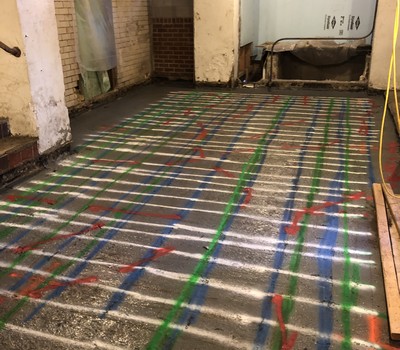Beyond the Surface: Leveraging Advanced Concrete Scanning Techniques for Unmatched Accuracy and Insight
Advanced concrete scanning methods have emerged as essential tools in this search, offering a peek beneath the surface area to unveil a world of crucial insights. By harnessing sophisticated innovations, specialists can uncover abnormalities, assess the problem of concrete structures, and make informed decisions that form the program of projects.
Relevance of Advanced Concrete Scanning
The relevance of utilizing innovative concrete scanning strategies hinges on the unequaled accuracy they offer for finding sub-surface anomalies and making certain structural honesty. By employing innovative modern technologies such as ground-penetrating radar (GPR), electro-magnetic induction, and advanced sonar imaging, building and construction experts can dig beneath the surface area of concrete frameworks with a degree of accuracy that much goes beyond standard assessment techniques. Concrete Scanning. These strategies enable the identification of covert threats like rebar corrosion, gaps, conduits, or post-tension cords that can compromise the security and safety and security of a framework over time
Furthermore, progressed concrete scanning gives very useful insights right into the general problem of a concrete component without the need for invasive actions, minimizing the threat of triggering damages during the assessment procedure. The ability to identify the specific place and deepness of possible concerns permits targeted repair services and maintenance, eventually prolonging the life-span of the framework and maximizing its performance. Fundamentally, the importance of innovative concrete scanning can not be overstated in the world of building and construction and framework upkeep, where accuracy and reliability are extremely important.
Kinds Of Cutting-Edge Technologies

Abnormalities and Defect Discovery
In enhancement to GPR, concrete scanning methods like thermography and impact-echo testing are likewise effective in finding abnormalities and defects. By leveraging these innovative strategies, professionals can proactively attend to architectural problems, guaranteeing the longevity and safety of concrete frameworks.
Assessing Concrete Problem
Just how can engineers accurately review the condition of concrete frameworks to guarantee their longevity and safety and security? Various innovative concrete great post to read scanning strategies are employed for this function. Ground-penetrating radar (GPR) is typically made use of to assess the interior framework of concrete, finding voids, cracks, and other abnormalities that may jeopardize its toughness.
Furthermore, aesthetic assessment continues to be a fundamental part of concrete problem analysis. Engineers aesthetically examine the surface area for signs of degeneration, such as spalling, fracturing, or discoloration. Integrating non-destructive screening techniques with aesthetic evaluations enables for a comprehensive examination of concrete problem, making it possible for engineers to identify prospective concerns at an early stage and carry out timely maintenance or repairs. By leveraging these advanced methods, designers can ensure the long-term toughness and safety and security of concrete frameworks.
Enhancing Decision-Making Processes
In the realm of facilities management, maximizing decision-making processes is necessary for guaranteeing the effective upkeep and long life of concrete structures. Boosted decision-making processes in concrete monitoring include utilizing sophisticated scanning methods to collect detailed information on the problem of structures. By leveraging modern technologies such as ground-penetrating radar and 3D imaging, stakeholders can make enlightened choices regarding substitute, repair work, or reinforcement techniques.
These advanced scanning strategies offer important understandings right into the inner composition of concrete, identifying possible problems such as you could look here gaps, cracks, or rust that might not be visible externally. This level of thorough information permits for positive maintenance planning, minimizing the risk of architectural failings and enhancing the general life-span of concrete frameworks.
Additionally, by incorporating digital paperwork and analysis tools right into the decision-making procedure, stakeholders can track the development of concrete conditions with time, enabling predictive upkeep approaches and maximizing source appropriation. Eventually, the combination of sophisticated concrete scanning methods boosts decision-making processes by giving unequaled precision, insight, and effectiveness in framework monitoring.
Verdict
In verdict, progressed concrete scanning methods use unrivaled accuracy and insight in discovering anomalies, problems, and analyzing the problem of concrete frameworks. By leveraging cutting-edge technologies, decision-making procedures can be improved, bring about more informed and reliable solutions for keeping and repairing concrete framework. These methods play a vital function in ensuring the safety and security and long life of concrete frameworks, making them an indispensable device in the area of building and construction and engineering.
In addition, progressed concrete scanning supplies indispensable insights right into the overall condition of a concrete element without the demand for invasive actions, minimizing the threat of causing damages throughout the evaluation procedure - Concrete Scanning. Another innovative modern technology is 3D X-ray scanning, which offers thorough photos of the inner structure of concrete, using valuable info without the need for devastating screening. In Addition, Concrete Cover Meters are used to determine the density of concrete cover over reinforcement bars precisely. Improved decision-making procedures in concrete monitoring include making use of sophisticated scanning methods to collect detailed data on the problem of frameworks.In conclusion, progressed concrete scanning strategies offer unparalleled accuracy and insight in identifying anomalies, problems, and assessing the condition of concrete frameworks